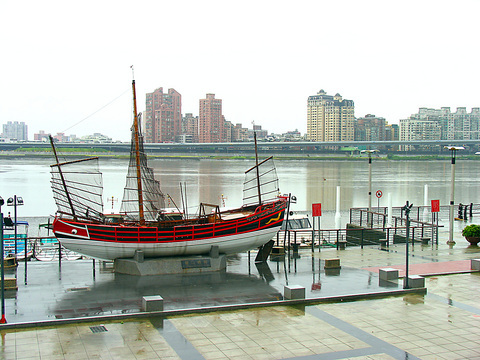Couples picnic on blankets beside the promenade. Children ride bicycles, daring to take off the training wheels. Shutterbugs snap as the sun sinks. These are all scenes to be seen at Taipei City's Dadaocheng Wharf (大稻埕碼頭). And what makes them special is that they weren't here a year ago.
In the past year, the Taipei City Government has spent a considerable sum of money to revitalize not only this wharf, but much of Datong district (大同區) in which it sits.
Chen Feng-yang (陳鳳揚), the neighborhood chief responsible for area, says the amount of money the government has spent is "in the hundreds of millions," but that it's a small price to pay to bring people back to one of Taipei's most historic districts.

PHOTO, DAVID MOMPHARD, TAIPEI TIMES
"It's especially nice to see young people coming here and couples bringing their children," he said. "Datong district's residents are mostly elderly people. They remember when this neighborhood was the heart of Taipei. Creating this riverside park is a good first step, but there is still a lot that needs to be done to make Datong District the place it once was." Among the renovations at Dadaocheng Wharf are a paved promenade along the Tamshui River (淡水河) and a bicycle path through the area that connects with another along the Keelung River (基隆河) and beyond. During weekends, bicycles can be rented at Dadaocheng. Also on weekends, a concessions stand is open for business and refreshments can be enjoyed at one of the umbrella-topped tables on the new veranda.
The harbor is also one of the major points of entry and exit along the recently opened Blue Highway tours of Taipei's rivers. Passengers can board at Dadaocheng and ply the river to Danshui for dinner.
The view from Dadaocheng is acceptable too. Taipei Bridge can be seen to the north and visitors learn from a plaque that it was built in 1925 to replace the original wooden railroad bridge first built in 1893, before being rebuilt again in 1966 and 1991.
Another plaque tells of how Dadaocheng and Datong district became one of Taiwan's most thriving areas around 1869 for the tea trade that flourished here.
"Several of those tea companies are still doing business here," Chen said. "But we look forward to when Datong district flourishes again."

On April 26, The Lancet published a letter from two doctors at Taichung-based China Medical University Hospital (CMUH) warning that “Taiwan’s Health Care System is on the Brink of Collapse.” The authors said that “Years of policy inaction and mismanagement of resources have led to the National Health Insurance system operating under unsustainable conditions.” The pushback was immediate. Errors in the paper were quickly identified and publicized, to discredit the authors (the hospital apologized). CNA reported that CMUH said the letter described Taiwan in 2021 as having 62 nurses per 10,000 people, when the correct number was 78 nurses per 10,000

As we live longer, our risk of cognitive impairment is increasing. How can we delay the onset of symptoms? Do we have to give up every indulgence or can small changes make a difference? We asked neurologists for tips on how to keep our brains healthy for life. TAKE CARE OF YOUR HEALTH “All of the sensible things that apply to bodily health apply to brain health,” says Suzanne O’Sullivan, a consultant in neurology at the National Hospital for Neurology and Neurosurgery in London, and the author of The Age of Diagnosis. “When you’re 20, you can get away with absolute

May 5 to May 11 What started out as friction between Taiwanese students at Taichung First High School and a Japanese head cook escalated dramatically over the first two weeks of May 1927. It began on April 30 when the cook’s wife knew that lotus starch used in that night’s dinner had rat feces in it, but failed to inform staff until the meal was already prepared. The students believed that her silence was intentional, and filed a complaint. The school’s Japanese administrators sided with the cook’s family, dismissing the students as troublemakers and clamping down on their freedoms — with

As Donald Trump’s executive order in March led to the shuttering of Voice of America (VOA) — the global broadcaster whose roots date back to the fight against Nazi propaganda — he quickly attracted support from figures not used to aligning themselves with any US administration. Trump had ordered the US Agency for Global Media, the federal agency that funds VOA and other groups promoting independent journalism overseas, to be “eliminated to the maximum extent consistent with applicable law.” The decision suddenly halted programming in 49 languages to more than 425 million people. In Moscow, Margarita Simonyan, the hardline editor-in-chief of the